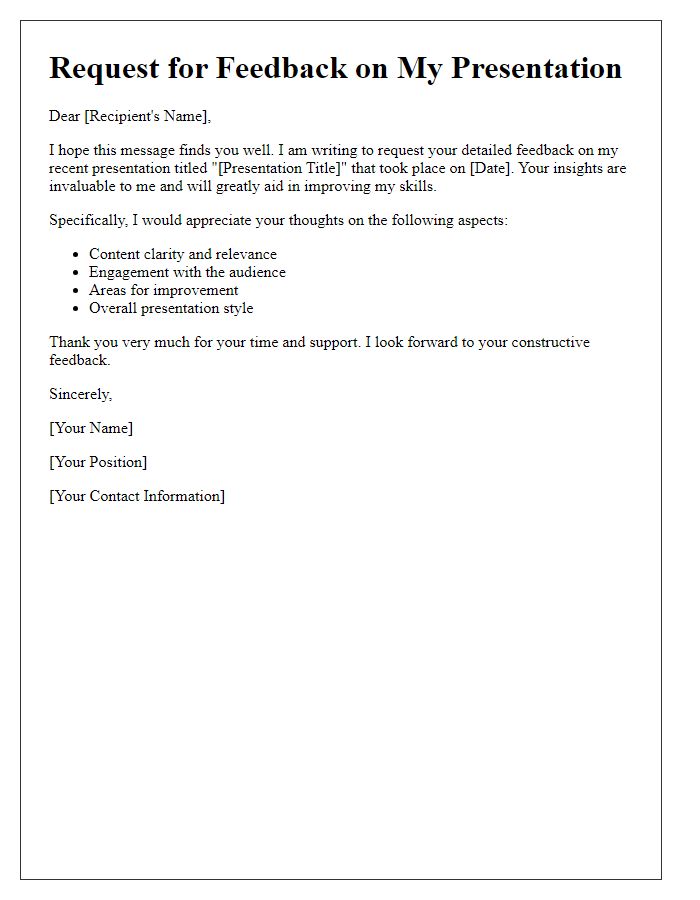Have you recently delivered a presentation and found yourself eager to know how it resonated with your audience? Seeking feedback can be an invaluable way to refine your skills and understand what worked well, as well as what could use improvement. By crafting a thoughtful letter requesting feedback, you open the door to insightful comments that can enhance your future presentations. If you're curious about how to create an effective feedback request, keep reading for tips and a sample template to get you started!

Subject Line Optimization
Subject line optimization involves crafting impactful and concise titles for emails that encourage recipients to open and engage with the content. For instance, using keywords such as "Feedback Request: Recent Presentation on Sustainable Energy" can convey urgency and relevance. Including the date, such as "Your Insights Needed: Feedback on My October 15 Presentation," can help recipients recall the event easily. Furthermore, employing action-oriented phrases like "Share Your Thoughts: Evaluate My Presentation on Digital Marketing Trends" emphasizes the desired outcome. Personalization, such as addressing the recipient's expertise or previous attendance, significantly increases the likelihood of receiving constructive feedback. Pay attention to length, keeping subject lines between 6 to 10 words for optimal visibility on various devices.
Personalization and Tone
Feedback on presentation is crucial for growth. Personalization plays a significant role in ensuring messages resonate with diverse audiences. Incorporating the audience's preferences can enhance engagement and relatability. Tone sets the atmosphere, where a friendly, respectful demeanor can foster openness. Understanding the audience's background can help tailor content effectively. Requesting feedback post-presentation can provide insights into areas needing improvement and strengths to build upon, directly impacting future presentations. Gathering this feedback is essential for continuous refinement and establishing a connection with the audience.
Specific Feedback Requests
A request for feedback following a presentation on software development methodologies can enhance the understanding of audience engagement and content clarity. Key points may include evaluation of delivery style (e.g., pace, tone, body language), audience interaction (number of questions asked, level of engagement), and clarity of technical concepts (e.g., Agile, Scrum, and Waterfall methodologies). Additionally, feedback regarding visual aids (e.g., PowerPoint slides, infographics) can reveal their effectiveness in conveying complex information. Specific areas such as the depth of information presented, examples used to illustrate points, and overall audience retention rates should be analyzed. Understanding these aspects can provide critical insights for refining future presentations and enhancing communication strategies.
Clear Call to Action
Feedback on presentations plays a crucial role in enhancing communication skills and content delivery. After presenting at a recent corporate event in New York City, involving over 300 attendees, it is essential to gather insights to improve future performances. Encouraging colleagues and participants to provide specific feedback regarding clarity, engagement, and overall effectiveness can lead to valuable recommendations. Targeted questions about content relevance, visual aids used during the presentation, and audience interaction will foster a comprehensive understanding of areas needing improvement. A well-structured feedback process will ensure continuous growth and adaptability in presentation styles.
Contact Information
Receiving feedback on presentations significantly enhances personal and professional growth. Valuable insights from experienced colleagues can inform improvements and highlight strengths. Presentations often occur in corporate settings or academic institutions, where clear communication impacts decision-making. Effective feedback addresses specific elements such as clarity, engagement level, and overall message delivery. Timely responses following presentations, typically within one week, allow for immediate reflection and adjustments in future endeavors. A constructive feedback process fosters a supportive environment, encouraging continuous improvement in presentation skills.
Letter Template For Request Feedback On Presentation Samples
Letter template of solicitation for constructive criticism on my presentation

Letter template of request for thoughts on my presentation effectiveness

Letter template of appeal for suggestions regarding my presentation style

Letter template of request for opinions on presentation engagement techniques

Letter template of survey request for audience feedback on presentation delivery









Comments